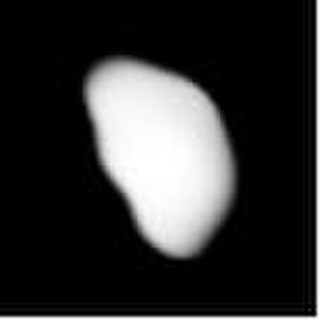
Victoria is a large main-belt asteroid, orbiting the Sun with a period of 3.56 years and an eccentricity of 0.221. It is a stony (S-type) asteroid, about 112–124 km across with an albedo of 0.18 and a rotation period of 8.66 hours. Victoria has been observed to occult a star three times since its discovery. Radar and speckle interferometry observations show that the shape of Victoria is elongated, and it is suspected to be a binary asteroid, with a moon of irregular shape.

Proserpina is a main-belt asteroid discovered by German astronomer R. Luther on May 5, 1853. It is named after the Roman goddess Proserpina, the daughter of Ceres and the Queen of the Underworld. Another main-belt asteroid, 399 Persephone, discovered in 1895, is named after her Greek counterpart.

Circe, minor planet designation 34 Circe, is a large, very dark main-belt asteroid. It was discovered by French astronomer J. Chacornac on April 6, 1855, and named after Circe, the bewitching queen of Aeaea island in Greek mythology.

Hestia is a large, dark main-belt asteroid. It is also the primary body of the Hestia clump, a group of asteroids with similar orbits.
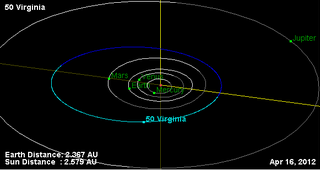
Virginia is a large, very dark main belt asteroid. It was discovered by American astronomer James Ferguson on October 4, 1857, from the United States Naval Observatory in Washington, D.C. German astronomer Robert Luther discovered it independently on October 19 from Düsseldorf, and his discovery was announced first.

Leto is a large main belt asteroid that is orbiting the Sun. The asteroid was discovered by German astronomer Robert Luther on April 29, 1861, and is named after Leto, the mother of Apollo and Artemis in Greek mythology. It is orbiting at a distance of 2.78112 AU with a period of 4.64 years and an orbital eccentricity of 0.187. The orbital plane is inclined at an angle of 7.97° to the ecliptic.

Freia is a very large main-belt asteroid. It orbits in the outer part of the asteroid belt and is classified as a Cybele asteroid. Its composition is very primitive and it is extremely dark in color. Freia was discovered by the astronomer Heinrich d'Arrest on October 21, 1862, in Copenhagen, Denmark. It was his first and only asteroid discovery. It is named after the goddess Freyja in Norse mythology.
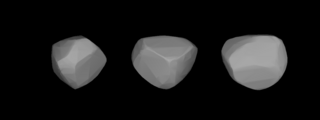
Ianthe is a large main-belt asteroid, named for three figures in Greek mythology. It is very dark and is composed of carbonates. It was one of the numerous discoveries by C. H. F. Peters, who found it on April 18, 1868, from Clinton, New York.
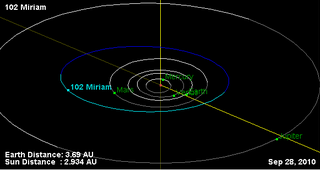
Miriam is a moderately large, very dark main belt asteroid. It was discovered by C. H. F. Peters on August 22, 1868, from the Litchfield Observatory.
Dione is a large main-belt asteroid. It probably has a composition similar to 1 Ceres. It was discovered by J. C. Watson on October 10, 1868, and named after Dione, a Titaness in Greek mythology who was sometimes said to have been the mother of Aphrodite, the Greek goddess of love and beauty. It is listed as a member of the Hecuba group of asteroids that orbit near the 2:1 mean-motion resonance with Jupiter. The orbital period for this object is 5.66 years and it has an eccentricity of 0.17.

Iphigenia is a fairly large and exceedingly dark main-belt asteroid. It is classified as a C-type asteroid, and therefore probably has a primitive carbonaceous composition. It was discovered by German-American astronomer C. H. F. Peters on September 19, 1870, and named after Iphigenia, a princess sacrificed by her father in Greek mythology. The orbital elements for 112 Iphigenia were published by German astronomer Friedrich Tietjen in 1871.
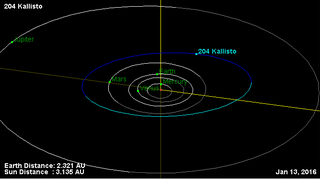
Kallisto is a fairly typical, although sizeable Main belt asteroid. It is classified as an S-type asteroid. Like other asteroids of its type, it is light in colour. It was discovered by Johann Palisa on 8 October 1879, in Pola, and was named after the same nymph Callisto in Greek mythology as Jupiter's moon Callisto.
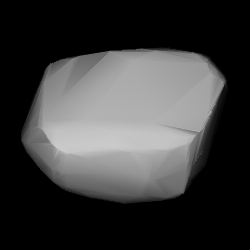
Chicago is a very large main-belt asteroid. It is classified as a C-type asteroid and is probably composed of carbonaceous material.

Devosa is a large Main belt asteroid. It was discovered by Auguste Charlois on 22 September 1892 in Nice. The asteroid is orbiting the Sun at a distance of 2.38 AU with a period of 3.68 years and an eccentricity (ovalness) of 0.14. These orbital elements are similar to that of the large asteroid 4 Vesta. The orbital plane of 337 Devosa is tilted at an angle of 7.85° to the plane of the ecliptic.

Arsinoë, minor planet designation 404 Arsinoë, is a large main-belt asteroid. It is classified as a C-type asteroid and is probably composed of carbonaceous material.
Aurelia is a main-belt asteroid that was discovered by German astronomer Max Wolf on September 7, 1896, in Heidelberg. It is classified as an F-type asteroid.
Bertholda is a very large main-belt asteroid. It was discovered by Max Wolf on September 7, 1896, in Heidelberg, Germany. The object is part of the Cybele asteroid group, and is classified as a P-type asteroid.
Merapi is a main belt asteroid orbiting the Sun. It was discovered by American astronomer George Henry Peters on May 11, 1904, from Washington, D.C.
650 Amalasuntha is a minor planet orbiting the Sun that was discovered by German astronomer August Kopff on October 4, 1907, at Heidelberg. It was named after Amalasuntha, the queen of the Ostrogoths from 526 to 534 AD. The name may have been inspired by the asteroid's provisional designation 1907 AM.

720 Bohlinia is a minor planet orbiting the Sun that was discovered by Franz Kaiser, a German astronomer in 1911. It is named for Swedish astronomer Karl Petrus Theodor Bohlin, to mark his 65th birthday. He had worked on the orbits of asteroids.















